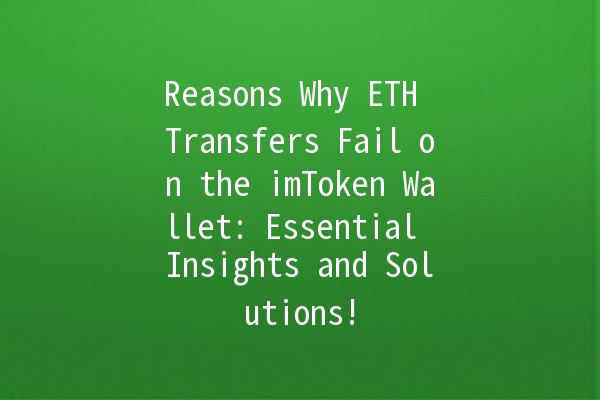In the everevolving landscape of cryptocurrency, imToken has emerged as one of the most popular wallets for managing Ethereum (ETH) and various tokens. However, users may occasionally encounter issues when attempting to transfer ETH, leading to frustrations and concerns. Understanding the reasons behind these transfer failures can empower users to troubleshoot effectively and ensure successful transactions. This article delves deep into the various factors that might cause ETH transfer failures on imToken, and offers actionable insights to avoid these problems.
When sending ETH or tokens on the Ethereum network, a gas fee is required. This fee compensates miners for validating and processing transactions. The gas fee fluctuates based on network demand; if it is set too low, a transaction may be stuck or outright failed.
Imagine you are trying to transfer ETH during a peak period when network congestion is high. If you set a gas fee that is below the recommended amount, your transaction might not get processed in time, leading to a failure. Users should always check gas prices using tools like EthGasStation or GasNow before making transactions.
Always ensure your gas price is set to at least the recommended rate during busy times or adjust it based on network activity using realtime tracking tools.

Network congestion occurs when there are too many transactions being processed at once, causing delays and potential failures. When the Ethereum network experiences high activity, it may struggle to process all pending transactions.
For instance, during major events in the crypto space, such as token launches or highprofile NFT drops, the network can become overwhelmed. If you try to transfer ETH during these moments without adjusting your settings, your transaction could fail due to congestion.
Monitor network status and consider timing your transactions during offpeak hours. Tools like Etherscan's network status feature can help you analyze activity trends.
In the world of cryptocurrency, sending funds to an incorrect address can lead to irreversible losses. If the recipient address is invalid, the transaction will fail.
Suppose you accidentally type in a wrong character or miss a digit while entering the recipient's Ethereum address. In this case, the transaction will not go through. This is especially critical when dealing with long addresses.
Doublecheck the recipient's address before initiating the transaction. Use the copyandpaste method wherever possible to minimize errors.
Using an outdated version of the imToken wallet may lead to compatibility issues or bugs, which can affect transaction success.
If imToken releases an update that includes important fixes or improvements, failing to update your app can lead to problems when sending ETH. Users could find themselves unable to access certain features or facing technical issues that hinder successful transactions.
Regularly update your wallet app to the latest version and check the app store for updates to avoid encountering bugs related to outdated software.
ImToken employs various security features, such as multisignature confirmations and transaction limits, to protect users. These can sometimes inadvertently block or fail transactions.
If you've set a limit on the maximum amount you can transfer, attempting to send more than this limit will result in transaction failure. Similarly, if your wallet detects suspicious activity, it might halt transactions as a precaution.
Review your wallet settings related to security and transaction limits. Ensure you are aware of any restrictions you may have set, especially if planning larger transactions.
Every ETH transfer requires enough ETH not only for the amount being sent but also to cover the gas fees. Users might miscalculate and only consider the amount they wish to send.
For example, if you want to send 0.1 ETH but have only 0.1 ETH in your wallet, your transaction will fail because you need additional ETH to pay for the gas fee.
Always maintain a small reserve of ETH in your wallet to cover gas fees. It’s advisable to keep at least a small fraction of ETH in your wallet to cover transaction costs.
The reliability of your internet connection plays a significant role in executing transactions. Inadequate connectivity can lead to timeouts or failure to initiate a transaction altogether.
If you are using a public WiFi network with low reliability while trying to send ETH, your transaction might not process correctly, resulting in errors or failures.
Ensure you are on a stable and secure network when executing cryptocurrency transactions. Avoid public networks unless absolutely necessary.
If your transaction fails, you should first check your wallet for any error messages. Make sure to ensure sufficient balance for gas fees and confirm the recipient's address. After that, adjust your gas fees as necessary and attempt the transaction again.
You can track your transaction status using Etherscan. Simply paste your transaction hash or wallet address to view its status. This will give you insight into whether it’s pending, successful, or failed.
Yes, users can set their transaction limits within the wallet for security purposes. If you attempt to transfer an amount exceeding this limit, the transaction will be unsuccessful.
Repeated transfers can trigger security protocols within your wallet. If you plan to send multiple transactions, it's advisable to space them out or ensure that your wallet doesn’t flag them as suspicious.
When a transaction fails, the ETH is not deducted from your wallet. However, if gas fees were applied during the transaction attempt, they may still be deducted.
Yes, using thirdparty services can sometimes interfere with wallet permissions and settings, leading to transaction failures. It’s best to conduct transactions directly through the imToken wallet.
By understanding the potential pitfalls associated with ETH transfers on imToken, users can mitigate the risks involved and ensure a smooth transaction experience. Take these insights to heart and empower yourself to navigate the complexities of cryptocurrency with confidence!